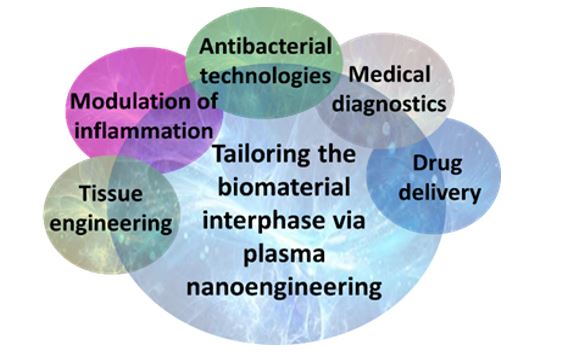Graphical Abstract

Abstract
In this Fellow Lecture, I will give an overview of recent progress from my lab on development of advanced nanoengineered surfaces capable of controlling infection and inflammation, and are the heart of diagnostic technologies. Over the last few years, we have created the means to control the entire spectrum of surface properties including chemical, physical, mechanical and topographical. We do that by nanoengineering and tailoring traditional plasma polymer films using tools from nanotechnology. By controlling surface properties, we are able to address medical challenges that are often encountered with implantable devices such as infection and inflammation. We have developed four distinct classes of antibacterial surfaces that are suitable for application on various medical devices. These surfaces can be classified based on their mechanism of action as non-stinky, contact killing, antimicrobial compound releasing and stimuli responsive. I will provide examples and describe the strategies used to achieve such surfaces, including such being translated onto commercial devices in collaboration with industry. I will also discuss the advantages and drawbacks of using certain type of antibacterial technology. We have strong interest in understanding the inflammatory responses to surfaces, and particularly, the interplay between surface nanotopography and chemistry in regulating these physiological processes. We found that when these parameters are used in an optimal way, we can achieve surfaces that reduce the expression of pro-inflammatory cytokines but increase the production of pro-healing markers such as arginase. Recently, we have also revealed that the mechanism of surface nanotopography induced modulation of inflammation is the unfolding of adsorbed fibrinogen. This unfolding is surface nanotopography scale dependent and leads to the exposure of (normally hidden) peptide sequences that activate the MAC-1 receptor of macrophages. In my talk, I will also give examples of how we use our surface nanoengineering expertise to create diagnostic devices which are now in clinical trials.
Keywords
Surface nanoengineering, antibacterial coatings, inflammation, diagnostics, medical devices.
Acknowledgement
KV thanks ARC for DP15104212 and DP180101254, NHMRC for fellowship APP1122825 and Project grant APP1032738, and the Alexander von Humboldt Foundation for Fellowship for Experienced Researchers.
References
- Visalakshan, R.M.; Cavallaro, A.A.; Macgregor, M.N.; Lawrence, E.P.; Koynov, K.; Hayball, J.D.; Vasilev, K.; Advanced Functional Materials, 2019, 29(14), 1970088.
- Chen, Z.; Bachhuka, A.; Han, S.; Lu, S.; Visalakshan, R.; Vasilev, K.; Xiao, Y.; ACS Nano, 2017, 11(5), 4494-4506
- MacGregor-Ramiasa, M.; McNicholas, K.; Ostrikov, K.; Li, J.; Michael, M.; Gleadle, J.; Vasilev, K.; Biosen & Bioelectron, 2017, 96, 373-380.
- Ramiasa, M.N.; Mierczynska, A.; Sedev, R.; Vasilev, K.; Nanoscale, 2016, 8, 4635-4642
- Taheri, S.; Cavallaro, A.; Christo, S.N.; Smith, L.; Majewski, P.; Barton, M.; Hayball, J.D.; Vasilev, K.; Biomaterials, 2014, 35(16), 4601-4609.
Biography
Krasimir Vasilev completed his PhD at the Max-Planck Institute for Polymer Research in Mainz, Germany in 2005. He is currently an NHMRC Fellow and a Humboldt Fellow, and a Full Professor at the University of South Australia. His research focuses on engineering and tailoring at a molecular level of the disciplinary interphase, where biological entities interact with biomaterials and devices. He is the author of more than 250 publications, 5 patents and has been awarded in excess of 20 million dollars of research funding. His papers have been cited more than 8500 times and his H-index=52 (M index~3). His work results in translation of research discoveries to tangible commercial outcomes such as device for bladder cancer diagnostics and antibacterial surface for hip and knee implants, both technologies being currently industrialized with commercial partners. For his work, he has received various honors and awards such as the John A. Brodie Medal for achievements in Chemical Engineering in 2016 and the International Association of Advanced Materials Medal (IAAM medal) for contributions to the field of Advanced Materials in 2017. In 2017, he was elected a Fellow of the Royal Society of Chemistry (FRSC).
Video Proceedings of Advanced Materials

Upcoming Congress



